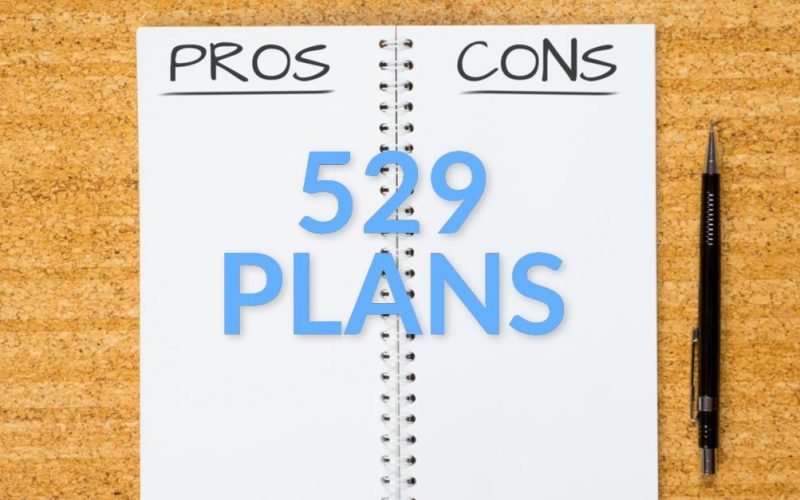Saving for a child’s education is a significant financial goal for many parents. With the ever-increasing college tuition and expenses costs, exploring various options to make education savings more manageable and efficient is essential. Have you weighed the pros and cons of using 529 plans?
Designed specifically for education savings, 529 plans offer numerous benefits and potential drawbacks. Hence, this article on the pros and cons of using 529 plans. We will provide a comprehensive understanding of what they are, how they work, and the implications they carry for families planning their children’s future education.
By examining the benefits and drawbacks, you will better understand these plans and be better equipped to make an informed decision regarding your education savings strategy.
So, let’s assess whether they fit your family’s educational aspirations.
Table of contents
What is a 529 plan?
A 529 plan is a tax-advantaged savings account created to encourage families to save for future education expenses.
Named after Section 529 of the Internal Revenue Code, these plans are sponsored by states, state agencies, or educational institutions.
They are available to parents and grandparents, providing a flexible means of setting aside funds for a child’s college or K-12 education.
The operation of a 529 plan is relatively straightforward. Parents or grandparents contribute funds into the account, which then grow tax-deferred.
The earnings generated within the plan are not subject to federal income tax, and in most cases, state taxes are also waived if the funds are used for qualified education expenses.
These expenses typically include tuition, fees, books, supplies, and room and board for eligible educational institutions. Moreover, some states even offer additional tax deductions or credits for contributions made to their specific 529 plans.
While 529 plans offer clear advantages, it is crucial to consider their pros and cons before deciding. On the one hand, the tax advantages and potential for investment growth can significantly boost savings over time.
Additionally, the flexibility to transfer funds between beneficiaries, the absence of income restrictions, and the high contribution limits make 529 plans accessible to families at various income levels.
Conversely, there are potential downsides, such as limited investment options, penalties for non-qualified withdrawals, and potential impacts on financial aid eligibility.
In the following sections, we will explore the pros and cons of using 529 plans in more detail.
Read Also: Escaping the Clutches of a Toxic Roommate: 15 Survival Guide
Types of 529 plans
There are two main types of 529 plans:
1. College Savings Plans
College savings plans are the most common type of 529 plan. These plans allow families to save for future expenses, including college and sometimes K-12 education.
A college savings plan can cover tuition, fees, books, supplies, and room and board expenses at eligible educational institutions.
The investment options within college savings plans typically include a range of mutual funds or similar investment vehicles. The account value fluctuates based on the performance of the selected investments.
2. Prepaid Tuition Plans
Prepaid tuition plans, also known as prepaid tuition programs, allow families to prepay all or part of the future tuition costs at participating colleges and universities.
These plans lock in current tuition rates for future use, protecting against future tuition inflation.
Prepaid tuition plans are typically sponsored by states and have residency requirements. The funds can be used for tuition and, in some cases, mandatory fees.
However, they generally do not cover room and board expenses. Prepaid tuition plans may have limitations on eligible institutions and may not be available for use at out-of-state or private colleges.
Read Also: Pros and Cons of Greek Life on Campus | 2024 Truths
How Does a 529 plan work?
The way a 529 plan works can vary slightly depending on the specific plan and state, but the general mechanics remain the same. Here’s a breakdown of how a 529 plan typically operates:
1. Account Setup
To open a 529 plan, an account holder (usually a parent or grandparent) must choose a plan offered by a state or educational institution.
Each state has its own 529 plan, and some offer multiple plans. The account holder must fill out an application, provide personal information, and designate a beneficiary (the student who will use the funds for education expenses).
2. Contribution
Once the account is established, the holder can contribute to the 529 plan. Contributions can be made in various ways, such as lump-sum payments or regular donations.
The account holder can contribute up to the plan’s maximum limit, which is typically quite high, often exceeding $300,000 per beneficiary.
3. Investment Options
The 529 plan offers a range of investment options to grow the contributed funds. These options typically include age-based portfolios and individual investment funds.
The account holder can allocate the funds among the available investment options based on their risk tolerance and investment preferences. The earnings on investments within the 529 plan are not subject to federal income tax.
Read Also: Top 15 Amazing Spring Break Destinations in Florida for College Students
4. Tax Advantages
One of the primary advantages of a 529 plan is its tax benefits. While contributions to a 529 plan are not deductible on the federal tax return, the earnings generated within the plan are tax-free as long as they are used for qualified education expenses.
Additionally, many states offer tax deductions or credits for contributions made to their specific 529 plans, which can further reduce the account holder’s tax burden.
5. Qualified Education Expenses
The funds in a 529 plan can be used for various qualified education expenses. These expenses typically include tuition, fees, books, supplies, and equipment the educational institution requires.
Room and board expenses can sometimes be covered if the student is enrolled at least half-time. However, it’s important to note that non-qualified withdrawals from a 529 plan may be subject to federal income tax and a 10% penalty on the earnings portion of the withdrawal.
6. Flexibility
529 plans offer flexibility in terms of beneficiary designation. Suppose the intended beneficiary decides not to pursue higher education or doesn’t need all the funds.
In that case, the account holder can change the beneficiary to another eligible family member, such as a sibling, cousin, or even themselves, if they wish to continue their education.
7. Financial Aid Considerations
529 plans can impact eligibility for financial aid. The value of the 529 plan is typically considered an asset of the account owner, which may affect the student’s eligibility for need-based financial aid.
However, the impact is generally less significant than other assets like parental income.
What are the Pros and Cons of Using 529 Plans?
Pros:
529 plans offer several advantages for families saving for education expenses. Here are some key pros of using 529 plans:
1. Tax Benefits
One of the primary advantages of 529 plans is the tax benefits they provide. The earnings generated within the plan grow tax-deferred, meaning you don’t have to pay federal income tax on the investment gains as long as the funds are used for qualified education expenses.
Additionally, many states offer tax deductions or credits for contributions made to their specific 529 plans, which can further reduce the account holder’s state tax liability.
2. Higher Education Cost Hedging
With the ever-increasing higher education costs, 529 plans allow families to save and invest specifically for education expenses.
By starting early and taking advantage of the potential growth of investments over time, families can better prepare for the future costs of college or other qualified educational institutions.
This can help alleviate the financial burden when it comes time for the beneficiary to attend school.
Related Article: Can You Get a Student Finance Loan For a Second Degree?
3. Flexible Contribution Options
529 plans offer flexibility in terms of contribution amounts and frequency. There are generally no annual contribution limits, and many plans allow for significant total contribution limits that can exceed $300,000 per beneficiary.
This allows families to contribute as much as they are comfortable with and adjust their contributions based on their financial situation.
4. Potential State Incentives
Some states provide additional incentives to encourage participation in 529 plans. These incentives can include matching grants, scholarships, or other benefits for residents who contribute to their state’s plan.
Exploring the specific incentives your state offers can provide additional advantages in terms of savings and potential financial assistance.
5. Estate Planning Benefits
529 plans can offer estate planning benefits for account holders. Contributions to a 529 plan are considered completed gifts for federal gift tax purposes, which means they are removed from the account holder’s estate, reducing potential estate tax liabilities.
Additionally, account holders can make lump-sum contributions up to five times the annual gift tax exclusion amount without incurring federal gift tax or using any portion of their lifetime gift tax exemption.
6. Transferability and Flexibility
Suppose the designated beneficiary of a 529 plan doesn’t use all the funds or decides not to pursue higher education. In that case, the account holder can change the beneficiary to another eligible family member.
This flexibility allows for the funds to be used by another sibling, cousin, or even the account holder themselves if they decide to return to school. It provides versatility in adapting to changing educational plans within the family.
See this: Can I Get Student Loans Before School Starts? Best Expert Advice
Cons:
1. Limited Investment Options
While 529 plans provide investment options, the choices within each plan may be limited. Account holders typically select from a predetermined menu of investment funds or portfolios, which may not align with the account holder’s desired investment strategy or risk tolerance.
The lack of flexibility in investment options can disadvantage those who prefer more control over their investments.
2. Potential Penalties for Non-Qualified Withdrawals
Suppose funds from a 529 plan are withdrawn for non-qualified expenses, such as non-education-related expenses. In that case, they are subject to federal income tax and a 10% penalty on the earnings portion of the withdrawal.
This penalty can significantly reduce the account holder’s savings and investment gains. It is important to consider the potential tax consequences before making non-qualified withdrawals.
3. Impact on Financial Aid Eligibility
While 529 plans offer tax advantages, they can also impact financial aid eligibility. The assets held in a 529 plan are generally considered parental assets in the Free Application for Federal Student Aid (FAFSA) calculation.
A higher value in a 529 plan may reduce the student’s eligibility for need-based financial aid. It is essential to understand how a 529 plan may affect financial aid and consider other strategies for optimizing eligibility of financial assistance if it is a significant concern.
4. Loss of Control over Funds
Once funds are contributed to a 529 plan, the account holder has limited control over their use. The funds must be used for qualified education expenses, and non-qualified withdrawals may incur penalties and taxes.
This loss of control may disadvantage individuals who prefer more flexibility and autonomy in utilizing their savings.
5. State-Specific Limitations
Each state’s 529 plan may have its own set of limitations and restrictions. These include residency requirements, limitations on eligible educational institutions, and variations in available investment options.
Suppose the chosen state’s plan does not align with an account holder’s preferences or requirements. In that case, they may need to consider plans from other states, which may entail additional research and potential complexities.
6. Market Risk
As with any investment, there is always the risk of market fluctuations and potential loss of principal. While 529 plans are designed for long-term savings, investment losses are still possible.
Account holders should consider their risk tolerance and investment horizon when selecting investment options within a 529 plan.
Read Also: 35+ Creative Ideas for Stunning Room Collages: Collage Your Memories
FAQs
No, contributions to a 529 plan are not deductible on your federal tax return. However, the earnings on investments within the plan grow tax-free if used for qualified education expenses.
Qualified education expenses include tuition, fees, books, supplies, and, in some cases, room and board. However, non-qualified withdrawals may be subject to taxes and penalties.
Yes, the value of a 529 plan is generally considered an asset of the account owner (usually the parent) in the financial aid calculation.
This may impact the student’s eligibility for need-based financial aid. However, the impact is usually less significant than other assets like parental income.
Conclusion
Understanding the pros and cons of using the 529 plans is crucial for making informed decisions about education savings. However, it is essential to carefully evaluate the specific features, limitations, and potential impact on financial aid eligibility before committing to a particular plan.
Seeking guidance from a financial advisor can help navigate the complexities and determine whether a 529 plan is the right choice to meet individual education savings goals.
With careful consideration, families can make informed decisions and take advantage of the benefits that 529 plans offer to secure their children’s educational future.
References
- financestrategists.com – What Are 529 Plans?
- intuit.com – 529 plan pros and cons: Is it a good idea?
- lendingtree.com – What is a 529 Plan, and Should I Get One?






